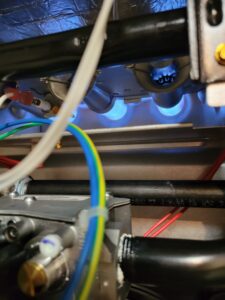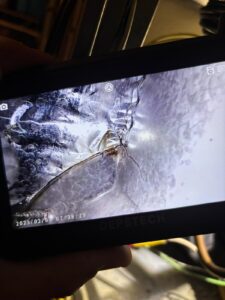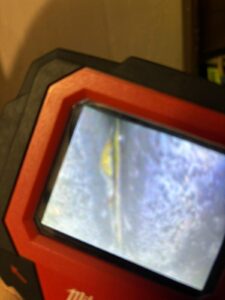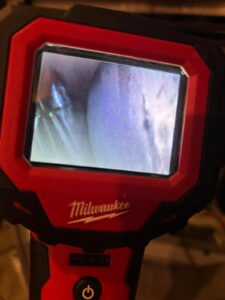What is a furnace heat exchanger?
The heat exchanger in your gas furnace is the part responsible for ensuring that harmful flue gases do not enter your home’s air. Your furnace creates heat using a combustion process. The heat exchanger works like a blocker between the combustion
chamber and the blower. The blower is responsible for distributing the heated air from your furnace through the air ducts and into your home. There is also an inducer motor where the heat exchanger sends the flue gases, so they are pushed through the flue pipe and out of a vent outside of your home. If the heat exchanger isn’t working, the harmful gas and combustion fumes (potentially including carbon monoxide) will be pushed directly through the blower and out into your home’s air, making it harmful to breathe.
How do I know if my furnace heat exchanger is bad?
A faulty heat exchanger in a furnace can be a serious issue, as it can lead to carbon monoxide leaks. Here are some signs to help you determine if your furnace heat exchanger is bad:
- Visible cracks or rust: Inspect the heat exchanger visually. Look for any visible cracks or rust on the surface. If you see cracks, it’s a clear indication of a problem. Ask your HVAC technician to camera the heat exchanger for you to verify the cracks. Better yet, look at the camera with them!
- Strange smells: A damaged heat exchanger can cause the release of unusual odors, including a strong metallic smell or the odor of combustion byproducts. If you notice any strange smells, it’s a cause for concern.
- Soot buildup: Excessive soot on the burners or around the furnace is a sign of incomplete combustion, which could be linked to a faulty heat exchanger.
- Carbon monoxide detector alarms: Install carbon monoxide detectors in your home, especially near the furnace. If the heat exchanger is leaking carbon monoxide, the detectors will alert you.
- Inconsistent heating: A malfunctioning heat exchanger may lead to uneven heating throughout your home. Some rooms may be warmer than others, indicating a problem with heat distribution.
- Flame color: The flame in the furnace should be blue. If you observe a yellow or flickering flame, it may indicate a problem with the heat exchanger.

There are other signs you have a cracked heat exchanger that may not be so obvious, and these are the health issues that you may be experiencing.
- Headaches
- Fatigue
- Nausea
There are many other issues that could be causing your symptoms, but these symptoms also match carbon monoxide poisoning which could indicate that harmful gases are leaking into your home’s air.
What makes a heat exchanger fail?
Each time your furnace calls for heat, the metal that makes up the heat exchanger expands as it warms up. Once the furnace turns off, then the metal contracts back down to its original size. This constant process of expanding and contracting can eventually lead to a crack over time, making age of the furnace the most common culprit for heat exchanger failure.
Other factors that can contribute to a failed heat exchanger include:
- Overheating: Continuous exposure to high temperatures, often caused by airflow issues, can lead to overheating and stress on the heat exchanger. This can result in cracks or warping.
- Dirty air filters: A dirty or clogged air filter can restrict airflow, causing the furnace to overheat. This can put additional strain on the heat exchanger and lead to premature failure.
- Incorrect sizing: If the furnace is not properly sized for the space it is heating, it may cycle on and off frequently, leading to thermal stress on the heat exchanger.
- Combustion issues: Irregularities in the combustion process, such as incomplete combustion or improper air-to-fuel ratios, can contribute to the deterioration of the heat exchanger.
- Impact damage: Physical damage, such as dents or impact, can compromise the integrity of the heat exchanger and lead to failure.
You can’t repair a heat exchanger, but here’s how to be sure it’s bad
It is not a standard process to clean or repair a heat exchanger. At the end of the day, it’s either good or bad. How can you be sure that your heat exchanger has gone bad? An HVAC service technician may inspect a heat exchanger with a combustion analyzer and/or a camera. The combustion analyzer will check inside your furnace to measure the amount of CO in your air. Anything over 100ppm (parts per million) inside of the flue pipe indicates a crack in the heat exchanger and the furnace must be shut down. This means that CO could already be present in your home’s air or will be if the furnace continues to operate. The heat exchanger at that point would need completely replaced as it is not possible to repair it. Ask your heating service technician to show you the combustion analyzer readings and/or the cracks in your heat exchanger. Sometimes visually seeing the damage to the heat exchanger can be difficult without taking the furnace apart depending on where it is located in your brand and model of furnace.


Replacing a heat exchanger
Can you replace just the heat exchanger instead of the entire furnace? The answer is yes! Depending on the age of the unit, it could actually make more financial sense to just replace the heat exchanger. If the furnace is more than 10 years old, then we would recommend furnace replacement instead since over 10 years of age other parts of the furnace may start to shut down soon as well.
READ MORE: Furnace Repair Vs. Furnace Replacement
Heat Exchanger Cost
The cost to replace a failed heat exchanger is typically somewhere between $900-$2,500 depending upon the size of the furnace and the cost of the particular heat exchanger that the furnace uses. Each brand of furnace may use a slightly different heat exchanger. Different manufacturers can also build their furnaces slightly differently, making the heat exchanger a more labor-intensive process to take out and replace, causing an increase in the labor cost of replacing the part.
Can’t I just wait until my carbon monoxide detector tells me I have a problem?
Don’t rely on your CO detector alone because that means a large amount of CO is now present inside your home and has been an ongoing problem. During a furnace tune up and inspection, your HVAC service technician can check for CO levels inside your furnace and hopefully catch an issue before the CO has actually began leaking out in large quantities into your home.
Schedule a furnace tune up
The best way to ensure continued furnace safety is to have an annual furnace tune up. If you are in the Cincinnati, OH area you can call 513-620-4822 or book online 24/7 with Quality Comfort Home Services.

